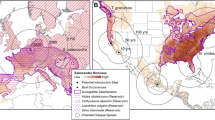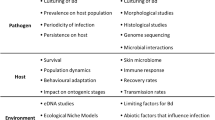Abstract
Considering that emerging infectious diseases are one of the major drivers of global amphibian decline, controlling the spread of infections are even more challenging. Amphibian skin disease chytridiomycosis, which is caused by two species of fungi belonging to the Batrachochytrium genus, has been detected in at least 700 amphibian species causing mass mortalities in all continents where amphibians occur. Most Alytes species, including the Betic midwife toad (A. dickhilleni), are highly susceptible to B. dendrobatidis (Bd) with lethal consequences. The presence of Bd infection in A. dickhilleni was confirmed ten years ago in just three localities across the entire distribution range of this threatened species. Here we report the extraordinary Bd expansion through the entire distribution range of A. dickhilleni and analyse if former infected populations acted as the source of transmission events to current infected populations. Currently, Bd infection is broadly distributed across the entire distribution range of the species and the increase of infection prevalence reached 30–50% during a decade. The populations where the infection was detected a decade ago could be identified as likely sources of infection for some locations where the pathogen is now present. The introduction of infected amphibian hosts into previously naïve A. dickhilleni breeding sites, and other anthropogenic processes, are seeming to be the most plausible way of Bd range expansion, motivating mass mortalities, population declines and extirpation events of this threatened amphibian species.


Similar content being viewed by others
Data availability
All relevant data are included in the manuscript.
References
Ayllón E, Bosch J (2020) El programa SARE de la Asociación Herpetológica Española: seguimiento de anfibios y reptiles en España. Spanish Ministry for the Ecological Transition and the Demographic Challenge Website. https://www.miteco.gob.es/es/red-parques-nacionales/boletin/boletin_64_anfibios_tcm30-510343.pdf. Accessed 7 January 2021
Baláž V, Vörös J, Civiš P et al (2014) Assessing risk and guidance on monitoring of Batrachochytrium dendrobatidis in Europe through Identification of taxonomic selectivity of infection. Conserv Biol 28:213–223. https://doi.org/10.1111/cobi.12128
Bates KA, Clare FC, O’Hanlon S et al (2018) Amphibian chytridiomycosis outbreak dynamics are linked with host skin bacterial community structure. Nat Commun 9:1–11. https://doi.org/10.1038/s41467-018-02967-w
Bielby J, Bovero S, Sotgiu G et al (2009) Fatal chytridiomycosis in the tyrrhenian painted frog. EcoHealth 6:27–32. https://doi.org/10.1007/s10393-009-0232-2
Blooi M, Pasmans F, Longcore JE et al (2013) Duplex real-Time PCR for rapid simultaneous detection of Batrachochytrium dendrobatidis and Batrachochytrium salamandrivorans in amphibian samples. J Clin Microbiol 51:4173–4177. https://doi.org/10.1128/JCM.02313-13
Bosch J, Martínez-Solano I, García-París M (2001) Evidence of a chytrid fungus infection involved in the decline of the common midwife toad (Alytes obstetricans) in protected areas of central Spain. Biol Conserv 97:331–337. https://doi.org/10.1016/S0006-3207(00)00132-4
Bosch J, Carrascal LM, Durán L et al (2007) Climate change and outbreaks of amphibian chytridiomycosis in a montane area of Central Spain; is there a link? Proc R Soc B Biol Sci 274:253–260. https://doi.org/10.1098/rspb.2006.3713
Bosch J, Tejedo M, Lizana M, et al (2009) Alytes dickhilleni (errata version published in 2016). The IUCN Red List of Threatened Species 2009: e.T979A86229986. https://doi.org/10.2305/IUCN.UK.2009.RLTS.T979A13099604.en. Accessed 10 July 2020
Bosch J, González-Miras E (2012) Seguimiento de Alytes dickhilleni: Informe final. Monografías SARE. Asociación Herpetológica Española, Ministerio de Agricultura, Alimentación y Medio Ambiente, Madrid
Bosch J, García-Alonso D, Fernández-Beaskoetxea S et al (2013) Evidence for the introduction of lethal chytridiomycosis affecting wild betic midwife toads (Alytes dickhilleni). EcoHealth 10:82–89. https://doi.org/10.1007/s10393-013-0828-4
Bosch J, Sanchez-Tomé E, Fernández-Loras A et al (2015) Successful elimination of a lethal wildlife infectious disease in nature. Biol Lett 11:20150874. https://doi.org/10.1098/rsbl.2015.0874
Boyle DG, Boyle DB, Olsen V et al (2004) Rapid quantitative detection of chytridiomycosis (Batrachochytrium dendrobatidis) in amphibian samples using real-time Taqman PCR assay. Dis Aquat Organ 60:141–148. https://doi.org/10.3354/dao060141
Briggs CJ, Knapp RA, Vredenburg VT (2010) Enzootic and epizootic dynamics of the chytrid fungal pathogen of amphibians. Proc Natl Acad Sci U S A 107:9695–9700. https://doi.org/10.1073/pnas.0912886107
Chaukulkar S, Sulaeman H, Zink AG, Vredenburg VT (2018) Pathogen invasion and non-epizootic dynamics in Pacific newts in California over the last century. PLoS ONE 13:1–10. https://doi.org/10.1371/journal.pone.0197710
Clare FC, Halder JB, Daniel O et al (2016) Climate forcing of an emerging pathogenic fungus across a montane multi-host community. Philos Trans R Soc B Biol Sci. https://doi.org/10.1098/rstb.2015.0454
Daszak P, Cunningham AA, Hyatt AD (2000) Emerging infectious diseases of wildlife - threats to biodiversity and human health. Science 287:443–449. https://doi.org/10.1126/science.287.5452.443
Dias G, Beltrán JF, Tejedo M et al (2015) Limited gene flow and high genetic diversity in the threatened Betic midwife toad (Alytes dickhilleni): evolutionary and conservation implications. Conserv Genet 16:459–476. https://doi.org/10.1007/s10592-014-0672-2
Doddington BJ, Bosch J, Oliver JA et al (2013) Context-dependent amphibian host population response to an invading pathogen. Ecology 94:1795–1804. https://doi.org/10.1890/12-1270.1
Faulkner SC, Stevenson MD, Verity R et al (2015) Using geographic profiling to locate elusive nocturnal animals: A case study with spectral tarsiers. J Zool 295:261–268. https://doi.org/10.1111/jzo.12203
Faulkner SC, Verity R, Roberts D et al (2016) Using geographic profiling to compare the value of sightings vs trap data in a biological invasion. Divers Distrib 23:104–112. https://doi.org/10.1111/ddi.12498
Faulkner SC, Stevens MCA, Romañach SS et al (2018) A spatial approach to combatting wildlife crime. Conserv Biol 32:685–693. https://doi.org/10.1111/cobi.13027
Fisher MC, Garner TWJ (2007) The relationship between the emergence of Batrachochytrium dendrobatidis, the international trade in amphibians and introduced amphibian species. Fungal Biol Rev 21:2–9. https://doi.org/10.1016/j.fbr.2007.02.002
Fisher MC, Garner TWJ (2020) Chytrid fungi and global amphibian declines. Nat Rev Microbiol 18:332–343. https://doi.org/10.1038/s41579-020-0335-x
Garmyn A, van Rooij P, Pasmans F et al (2012) Waterfowl: Potential environmental reservoirs of the chytrid fungus Batrachochytrium dendrobatidis. PLoS ONE 7:1–5. https://doi.org/10.1371/journal.pone.0035038
Lambert MR, Womack MC, Byrne AQ, et al (2020) Comment on “Amphibian fungal panzootic causes catastrophic and ongoing loss of biodiversity”. Science, 367. https://doi.org/10.1126/science.aay1838
Lawson B, Robinson RA, Fernandez JRR et al (2018) Spatio-temporal dynamics and aetiology of proliferative leg skin lesions in wild British finches. Sci Rep 8:1–12. https://doi.org/10.1038/s41598-018-32255-y
Liew N, Moya MJM, Wierzbicki CJ et al (2017) Chytrid fungus infection in zebrafish demonstrates that the pathogen can parasitize non-amphibian vertebrate hosts. Nat Commun 8:1–10. https://doi.org/10.1038/ncomms15048
Lips KR, Brem F, Brenes R et al (2006) Emerging infectious disease and the loss of biodiversity in a Neotropical amphibian community. Proc Natl Acad Sci U S A 103:3165–3170. https://doi.org/10.1073/pnas.0506889103
Lips KR, Diffendorfer J, Mendelson JR, Sears MW (2008) Riding the wave: Reconciling the roles of disease and climate change in amphibian declines. PLoS Biol 6:0441–0454. https://doi.org/10.1371/journal.pbio.0060072
McMahon TA, Brannelly LA, Chatfield MWH et al (2013) Chytrid fungus Batrachochytrium dendrobatidis has nonamphibian hosts and releases chemicals that cause pathology in the absence of infection. Proc Natl Acad Sci U S A 110:210–215. https://doi.org/10.1073/pnas.1200592110
Mitchell KM, Churcher TS, Garner TWJ, Fisher MC (2008) Persistence of the emerging pathogen Batrachochytrium dendrobatidis outside the amphibian host greatly increases the probability of host extinction. Proc R Soc B Biol Sci 275:329–334. https://doi.org/10.1098/rspb.2007.1356
Nguyen TT, Van NT, Ziegler T et al (2017) Trade in wild anurans vectors the urodelan pathogen Batrachochytrium salamandrivorans into Europe. Amphib Reptil 38:554–556. https://doi.org/10.1163/15685381-00003125
O’Hanlon SJ, Rieux A, Farrer RA et al (2018) Recent Asian origin of chytrid fungi causing global amphibian declines. Science 360:621–627. https://doi.org/10.1126/science.aar1965
Oficialdegui FJ, Sánchez MI, Monsalve-Carcaño C et al (2019) The invasive red swamp crayfish (Procambarus clarkii) increases infection of the amphibian chytrid fungus (Batrachochytrium dendrobatidis). Biol Invasions 21:3221–3231. https://doi.org/10.1007/s10530-019-02041-6
Picco AM, Collins JP (2008) Amphibian commerce as a likely source of pathogen pollution. Conserv Biol 22:1582–1589. https://doi.org/10.1111/j.1523-1739.2008.01025.x
Price SJ, Garner TWJ, Cunningham AA et al (2016) Reconstructing the emergence of a lethal infectious disease of wildlife supports a key role for spread through translocations by humans. Proc R Soc B Biol Sci 283:20160952. https://doi.org/10.1098/rspb.2016.0952
R Core Team, 2015. R: A language and environment for statistical computing. R Foundation for Statistical Computing, Vienna, Austria. https://www.R-project.org/. Accessed 20 May 2020.
Rachowicz LJ, Briggs CJ (2007) Quantifying the disease transmission function: Effects of density on Batrachochytrium dendrobatidis transmission in the mountain yellow-legged frog Rana muscosa. J Anim Ecol 76:711–721. https://doi.org/10.1111/j.1365-2656.2007.01256.x
Rodríguez-Brenes S, Rodriguez D, Ibáñez R, Ryan MJ (2016) Spread of amphibian chytrid fungus across lowland populations of Túngara frogs in panamá. PLoS ONE 11:1–8. https://doi.org/10.1371/journal.pone.0155745
Rosa GM, Anza I, Moreira PL et al (2013) Evidence of chytrid-mediated population declines in common midwife toad in Serra da Estrela, Portugal. Anim Conserv 16:306–315. https://doi.org/10.1111/j.1469-1795.2012.00602.x
Rossmo DK (2000) Geographic profiling. CRC Press, Florida
Scheele BC, Pasmans F, Skerratt LF et al (2019) Amphibian fungal panzootic causes catastrophic and ongoing loss of biodiversity. Science 363:1459–1463. https://doi.org/10.1126/science.aav0379
Searle CL, Biga LM, Spatafora JW, Blaustein AR (2011) A dilution effect in the emerging amphibian pathogen Batrachochytrium dendrobatidis. Proc Natl Acad Sci U S A 108:16322–16326. https://doi.org/10.1073/pnas.1108490108
Spitzen-van der Sluijs A, Martel A, Asselberghs J et al (2016) Expanding distribution of lethal amphibian fungus Batrachochytrium salamandrivorans in Europe. Emerg Infect Dis 22:1286–1288. https://doi.org/10.3201/eid2207.160109
Spitzen-Van Der Sluijs A, Martel A, Hallmann CA et al (2014) Environmental determinants of recent endemism of Batrachochytrium dendrobatidis infections in amphibian assemblages in the absence of disease outbreaks. Conserv Biol 28:1302–1311. https://doi.org/10.1111/cobi.12281
Stevenson MD, Rossmo DK, Knell RJ, Le Comber SC (2012) Geographic profiling as a novel spatial tool for targeting the control of invasive species. Ecography 35:704–715. https://doi.org/10.1111/j.1600-0587.2011.07292.x
Struebig MJ, Linkie M, Deere NJ et al (2018) Addressing human-tiger conflict using socio-ecological information on tolerance and risk. Nat Commun 9:3455. https://doi.org/10.1038/s41467-018-05983-y
Verity R, Stevenson MD, Rossmo DK et al (2014) Spatial targeting of infectious disease control: Identifying multiple, unknown sources. Methods Ecol Evol 5:647–655. https://doi.org/10.1111/2041-210X.12190
Vredenburg VT, Knapp RA, Tunstall TS, Briggs CJ (2010) Dynamics of an emerging disease drive large-scale amphibian population extinctions. Proc Natl Acad Sci U S A 107:9689–9694. https://doi.org/10.1073/pnas.0914111107
Vredenburg VT, McNally SVG, Sulaeman H et al (2019) Pathogen invasion history elucidates contemporary host pathogen dynamics. PLoS ONE 14:1–14. https://doi.org/10.1371/journal.pone.0219981
Walker SF, Bosch J, Gomez V et al (2010) Factors driving pathogenicity vs. prevalence of amphibian panzootic chytridiomycosis in Iberia. Ecol Lett 13:372–382. https://doi.org/10.1111/j.1461-0248.2009.01434.x
Walker SF, Bosch J, James TY et al (2008) Invasive pathogens threaten species recovery programs. Curr Biol 18:853–854. https://doi.org/10.1016/j.cub.2008.07.033
White LA, Forester JD, Craft ME (2017) Using contact networks to explore mechanisms of parasite transmission in wildlife. Biol Rev 92:389–409. https://doi.org/10.1111/brv.12236
Yap TA, Gillespie L, Ellison S et al (2016) Invasion of the fungal pathogen Batrachochytrium dendrobatidis on California Islands. EcoHealth 13:145–150. https://doi.org/10.1007/s10393-015-1071-y
Yon L, Duff JP, Ågren EO et al (2019) Recent changes in infectious diseases in european wildlife. J Wildl Dis 55:3–43. https://doi.org/10.7589/2017-07-172
Acknowledgements
Funding for this study was provided by the Consejería de Agricultura, Ganadería, Pesca y Desarrollo Sostenible of Junta de Andalucía. Special thanks to Jesús del Río, coordinator of the conservation program of endangered amphibians of Andalusia. We also thank Ester Cerezo-Valverde for field assistance, Cristina Sausor for laboratory assistance and Trenton WJ Garner for providing insightful and detailed comments on earlier versions of the paper.
Funding
This work was funded by the Consejería de Medio Ambiente of Junta de Andalucía (Contract Number NET378406/1).
Author information
Authors and Affiliations
Contributions
JB and EGM conceived the ideas and designed methodology. EGM, BT, and JB collected the samples. BT performed DNA extraction and qPCR analyses. SCF conducted geographic profiling analysis. JB and BT ran the statistical analyses. BT, SCF, and JB wrote the first draft; all authors contributed to revisions.
Corresponding author
Ethics declarations
Conflict of interests
The authors declare that they have no conflict of interest.
Ethical approval
Field work was carried out under permission of Consejería de Medio Ambiente of Junta de Andalucía, Castilla La Mancha and Región de Murcia.
Consent to participate
All the authors voluntarily agreed to participate in this research study.
Consent for publication
All the authors voluntarily consented publish this research study.
Additional information
Publisher's Note
Springer Nature remains neutral with regard to jurisdictional claims in published maps and institutional affiliations.
Supplementary Information
Below is the link to the electronic supplementary material.
Rights and permissions
About this article
Cite this article
Thumsová, B., González-Miras, E., Faulkner, S.C. et al. Rapid spread of a virulent amphibian pathogen in nature. Biol Invasions 23, 3151–3160 (2021). https://doi.org/10.1007/s10530-021-02571-y
Received:
Accepted:
Published:
Issue Date:
DOI: https://doi.org/10.1007/s10530-021-02571-y




